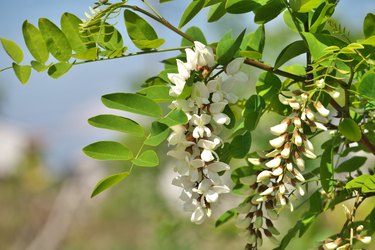
When you think of legumes, you may envision peas (Pisum sativum), beans (Phaseolus vulgaris) or peanuts (Arachis hypogaea). However, these garden staples aren't the only members of the legume family (Fabaceae) -- it includes trees with pea-like pods. Trees in the legume family are valuable because they use atmospheric nitrogen and have deep roots, making them excellent pioneer trees in harsh areas.
The Black Locust Tree
Video of the Day
The black locust (Robinia pseudoacacia) is a striking tree with fine, feathery foliage, hardy in U.S. Department of Agriculture plant hardiness zones 3 through 8. Native to the Eastern United States, black locusts are prized for their heavy, decay-resistant timber. This hardy species is also an excellent urban tree because it thrives in poor soil. It is often planted near sidewalks and parking lots, because it is resistant to the deicing salt products that may be applied during the winter in cold climates.
Video of the Day
Black locust flowers are fragrant and appear in late spring and early summer. These flowers develop into elongated pea-like pods in some varieties, although seedless varieties of the locust are available.
The Eastern Redbud Tree

The eastern redbud (Cercis canadensis) is one of the earliest flowering trees in USDA zones 4 through 9. A common ornamental, the eastern redbud is a relatively small tree with pods that grows throughout the eastern states and as far west as Texas and Kansas. It is at home either in the sun or in partial shade. Most varieties have blooms that are purplish pink, but a white variety is available.
Plant this tree as a single specimen tree or in a group. Both the flowers and the pods of this tree are edible. The flowers are used as garnish or blended into pancakes. Pick the pods when young and tender and prepare them with butter like snow peas.
The Silk Tree
The silk tree (Albizia julibrissin), or mimosa, is a native of Asia, originally imported for its fragrant, showy flowers. However, it is now a pest in many Southern states. This medium-sized tree with seed pods like beans thrives in USDA zones 6 through 9.
The flattened pods are 6 inches long and filled with seeds that stay viable for years. Wetland areas are particularly vulnerable to infestations, as the pods and seeds float downstream. Although this tree is still available in garden centers, homeowners should consider planting noninvasive redbuds or serviceberries instead.
The American Yellowwood Tree
The American yellowwood (Cladrastis kentukea), also known as Kentucky yellowwood, is a medium-sized tree with profuse, strongly scented blooms. It is native to Kentucky, Tennessee, Arkansas and Missouri with scattered populations in a few other states. It thrives in USDA zones 4 through 8.
American yellowwood is rarely planted in yards because it is slow growing and it may take 10 years to produce flowers. Its flowers are usually white, but a pink-flowered variety is available. This legume tree with green bean looking pods and smooth gray bark provides visual interest in the landscape during the winter months.